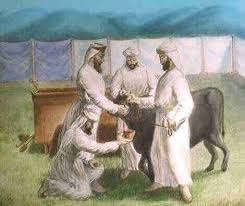Bring a Bull to the Front of the Tabernacle
and Slaughter It There
Exodus 29:10-14 and Leviticus 8:14-17
Bring a bull to the front of the Tabernacle and slaughter it there DIG: What was the difference in the three offerings? Why were they in that order? How did the sacrifice of the bull prefigure Christ’s sacrifice?
REFLECT: Were these rituals mainly for God’s benefit, the priests benefit or the peoples benefit? Why? How do we cleanse ourselves of our sin today (First John 1:9)?
After being washed in the bronze basin, dressed with the sacred garments and anointed with holy oil, the dedication service started. The three types of sacrifices consisted of first, one young bull for a sin offering (which atoned for their sin nature). The second sacrifice was a ram for a burnt offering (which atoned for unintentional sin). And the third sacrifice was a second ram, along with a basket of bread without leaven, cakes without leaven kneaded in oil, and thinner cakes without leaven sprinkled with oil, for a peace offering (which was a communal meal that the worshiper and his family ate before God). In other words, after the sin issue was taken care of, the priest was at peace with God.

First, a bull was brought to the bronze altar for a sin offering, atoning for their sin nature. At three separate times in the dedication service, Moses and his four sons laid their hands on the heads of each of the animals, in each case symbolizing the transfer of sin from the worshiper to the sacrifice (especially see Leviticus 16:21-22). Similarly, Jesus, Yeshua, bore our sins in His body on the tree, so that we might die to sins and live for righteousness (First Peter 2:24-25). When God the Father laid our sins on God the Son, Isaiah 53:6 was fulfilled, saying: ADONAI has laid on Him the iniquity of us all.638
The bull was the required sin offering for a priest (Leviticus 4:3-12). His sons were to become the first of the common priests, because all priests had to be direct descendants of Aaron. After being slaughtered, the blood of the bull was then put on the four horns of the bronze altar with the finger of Moses, and the rest was poured out at the base of the altar. That purified the bronze altar, because the blood purified that on which it was smeared. It was then ready for sacrificial use (Exodus 29:10-12; Leviticus 8:14-15).
Then all the fat around the inner parts, the covering of the liver, and both kidneys with the fat around them, was taken and burned on the bronze altar. But the bull’s flesh and its hide and its offal were burned outside the camp. This was a sin offering for both Aaron and his sons (Exodus 29:13-14; Leviticus 8:16-17).
Whether as a sin offering or as a burnt offering, certain parts of the slaughtered animal were to be burned. Those that were presented as a burnt offering on the bronze altar are described as emitting a pleasing aroma to ADONAI. Obviously, the burning was not a burning of destruction but of submission into something finer and more acceptable than it was before. Sacrifice involves dedication as atonement.
Jesus’ death freed us from our sins by His blood (Revelation 1:5), but it also represented an act of dedication on His part. Yeshua Messiah gave Himself up for us as a fragrant offering and sacrifice to God (Ephesians 5:2). Although we ourselves will never be able to die for another person and remove their sins, we can, in response to all that Christ has done for us, offer our bodies as living sacrifices, holy and pleasing to God (Romans 12:1). Such is the very least that we should be willing to give to God’s dear Son, who is at the same time our great High Priest and our Sacrifice (Hebrews 4:14 to 5:10, 6:19 to 7:28, 8:3, 9:1-28, 10:10, 14, 21-22; First Timothy 2:5).639



Leave A Comment